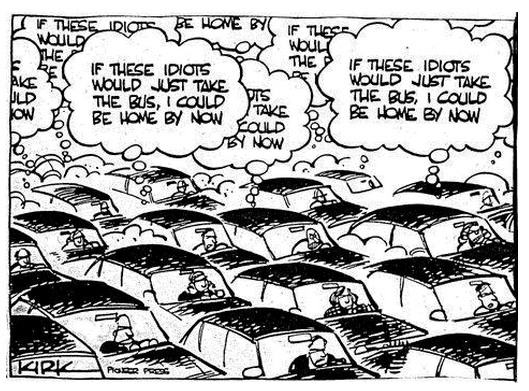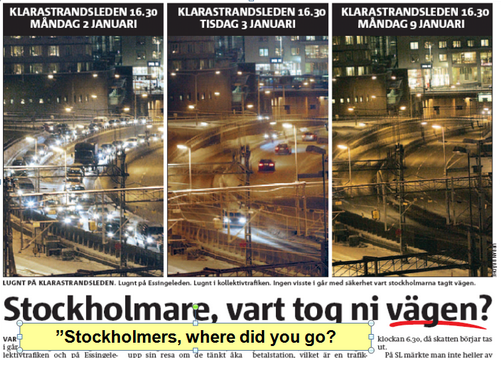Guest Post: For whom the road tolls?
.
For those of who were following Architect This City during the Gardiner Expressway East debate here in Toronto, you might remember that Darren Davis (transport planner with Auckland Transport) wrote a guest post called, Three minutes that rule the world – Will demolishing the Gardiner East actually make traffic worse?
It was an incredibly popular post at the time, so I’m thrilled that Darren volunteered to do another one on road tolls. This is a topic that I’m very interested in and have written about a few times. Road pricing, as you’ll see below, puts us in a bit of a chicken-and-egg situation. But sooner or later I think we will need to get our head around it, as will many other cities.

In a world where time is money, we are constantly berated about the economic costs of congestion. In 2011, the Toronto Board of Trade estimated that congestion in the Toronto region alone cost the regional economy $6 billion a year, rising to an estimated $15 billion in 2031 should no action be taken. More recent research by the CD Howe Institute pegs this figure at up to $11 billion.
Given these sorts of eye-watering figures, one might be tempted to think that car drivers, and in particular the goods industry, would be flinging their wallets open at the chance to buy their way out of congestion. And in fact Toronto has the 407 Express Toll Route which has elements of variable road pricing. However, while the 407 ETR carries around 350,000 vehicles per day, price increases have been matters of controversy. …
Similar stand-alone efforts to address congestion in Metro Vancouver with tolled routes, such as the Port Mann Bridge on the Trans-Canada Highway and the Golden Ears Bridge, have fallen well short of their projected traffic volumes, while nearby untolled bridges such as the Patullo Bridge are heavily congested. We have a similar experience in New Zealand where our two tolls roads, with car tolls of $2 and $2.20 respectively, experience diversion rates of up to 30% to the alternative but substantially longer and slower free routes.
This brings up a fundamental paradox: Congestion costs the economy a fortune and congestion is a top-of-mind frustration, yet people seem reluctant to pay even comparatively small amounts to bypass congestion. …
The very few cities that have actually had significant success at reducing traffic congestion – notably Singapore, London and Stockholm – have done this through cordon-based congestion pricing wherein if you pass the cordon, you pay the congestion charge. … The latest Travel in London report states that “Over the 10-year period from 2003, total trips have increased by 11.4 per cent … Car driver trips decreased by 12.7 per cent over the same period.” …
Stockholm has experienced a permanent reduction in traffic of about 20% across the toll cordon and congestion decreased by 30 – 50% – which demonstrates that traffic volume reductions have a disproportionately positive impact on congestion. About half of the “disappearing” drivers changed to transit, the rest to other alternatives such as different departure times and destinations and taking fewer trips.
For more on Stockholm, I suggest reading the Tools of Change case study on Stockholm Congestion Pricing.

Before and after congestion charge photos of traffic levels in Stockholm
.
While this sounds very promising, congestion charging has significant equity implications and requires upfront investment to provide people who either choose to or can no longer afford to drive with transportation alternatives. Both Stockholm and London invested very heavily in public transit in advance of implementing congestion charging.
And this brings up a big issue for Toronto.
For congestion charging to have a meaningful impact on congestion without stifling economic activity or impeding people’s ability to move around, the core capacity of Toronto’s transit system would need to be addressed first. In particular the Yonge Line capacity enhancements, Metrolinx’s Regional Express Rail and most likely the Downtown Relief Line would need to be in place to provide both capacity and choice for people who either needed or wanted a travel alternative to any congestion charge. This would mean that Metrolinx’s Big Move might need to get even bigger.
.
So what is the implication for Vancouver? If road pricing is the logical route to take following the defeat of the referendum, does the defeat of the referendum (and hence the unlikely possibility of expanding the transit system) mean that road pricing cannot be introduced?













Reblogged this on Adventures in Transitland!.
“For congestion charging to have a meaningful impact on congestion without stifling economic activity without stifling economic activity or impeding people’s ability to move around”
So congestion take a toll on the regional economy and imped people ability to move around or not?
Is the transit availability for road toll scheme a chicken and egg issue?
I effectively used to slightly think like it but not so quite (see https://voony.wordpress.com/2011/08/15/congestion-charge-the-case-for-vancouver/ ).
The transit availability is essentially a straw man issue or a rational for inaction: when transit is good enough?
A congestion toll is a yeld management method of the road space.
there is no reason it must be different for transit (adjust the demand by pricing, not the offer)…Andrew Coyne had an excellent talk at SFU last year on it.
Some minor points:
-London didn’t invest that massively in Transit ahead of the introduction of the congestion charge: subway and train were overcrowded as always. In fact subway ridership didn’t increased with the congestion charge introduction.. it even decreased, people preferring the suddenly freely moving buses! …London is investing much more now, 10 year later (crossrail,…).
Notice also that London doesn’t use a cordon based toll model, but an area one
-Singapore built its MRT after the introduction of its toll scheme
-Stockholm investment was essentially in new rail car (make train longer or more frequent)
…something we can also do in Vancouver for relatively cheap (especially if we buy the Scarborough RT cars for a song !)
more here